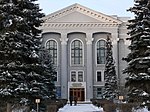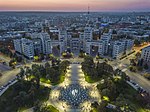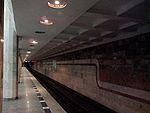Slovo Building
1928 establishments in UkraineAnti-Ukrainian sentimentBuildings and structures completed in 1928Crimes of the communist regime in Ukraine against UkrainiansCultural history of Ukraine ... and 6 more
History of Ukrainian literatureMassacres of UkrainiansPolitical repression in UkraineShevchenkivskyi District (Kharkiv)Stalinism in UkraineUkrainian Soviet Socialist Republic

Slovo Building (Ukrainian: Будинок «Слово») is a residential multi-story building located in the Shevchenkivskyi District of Kharkiv. The shape of the building reflects the letter C in the Ukrainian word слово ("slovo") which means "word". Therefore, the shape of the building symbolized that it was constructed specially for prominent Ukrainian writers, who lived there in a total of 66 apartments. Built in the late 1920s, it housed many Ukrainian writers and poets, some of whom, known as the Executed Renaissance, were later executed by the Soviet Union in Sandarmokh.
Excerpt from the Wikipedia article Slovo Building (License: CC BY-SA 3.0, Authors, Images).Slovo Building
Kultury Street, Kharkiv Derzhprom
Geographical coordinates (GPS) Address External links Nearby Places Show on map
Geographical coordinates (GPS)
| Latitude | Longitude |
|---|---|
| N 50.011666666667 ° | E 36.234166666667 ° |
Address
Будинок "Слово"
Kultury Street 9
61058 Kharkiv, Derzhprom
Kharkiv Oblast, Ukraine
Open on Google Maps









